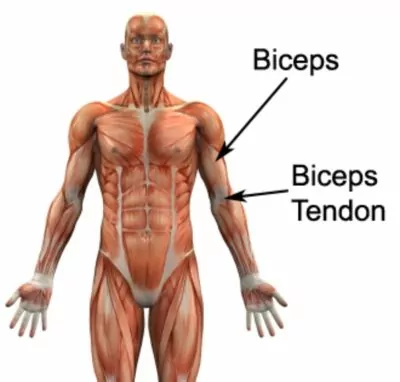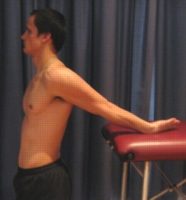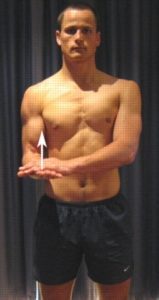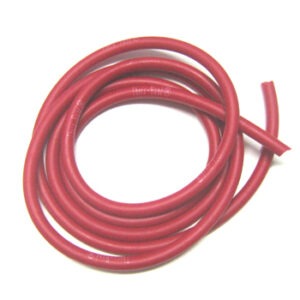Biceps Tendonitis
Updated:
(Also known as Bicep Tendonitis, Biceps Tendinopathy, Biceps Tendinitis)
N.B. Although research suggests that ‘biceps tendinopathy’ is the more appropriate term to describe overuse injuries to the biceps tendon, we will use the term ‘biceps tendonitis’ in this document as it is more widely known.
What is biceps tendonitis?
Biceps tendonitis is a condition characterized by tissue damage to the biceps tendon causing pain in the front of the elbow.
The muscle at the front of the upper arm is known as the biceps. The biceps originates from the front of the shoulder blade and inserts into the forearm via the biceps tendon (figure 1).

During contraction of the biceps, tension is placed through the biceps tendon. When this tension is excessive due to too much repetition or high force, damage to the biceps tendon occurs. Biceps tendonitis is a condition whereby there is damage to the biceps tendon with subsequent degeneration and inflammation. This may occur traumatically due to a high force going through the biceps tendon beyond what it can withstand or due to gradual wear and tear associated with overuse.
Causes of biceps tendonitis
Biceps tendonitis most commonly occurs due to repetitive or prolonged activities placing strain on the biceps tendon. This typically occurs due to excessive lifting, or bending of the elbow against resistance (such as performing chin ups or bicep curls). Occasionally it may occur suddenly due to a high force going through the biceps tendon beyond what it can withstand. This most commonly occurs during heavy weight lifting in a gym environment.
Signs and symptoms of biceps tendonitis
Patients with biceps tendonitis typically experience pain in the front of the elbow. In less severe cases of biceps tendonitis, patients may only experience an ache or stiffness in the elbow that increases with rest following activities requiring strong or repetitive contraction of the biceps muscle. These activities may include carrying heavy shopping, performing biceps curls or chin ups etc.
In more severe cases, patients may experience an ache that increases to a sharper pain with activity. Occasionally patients may notice swelling at the front of the elbow and experience weakness when attempting to lift objects.
Diagnosis of biceps tendonitis
A thorough subjective and objective examination from a physiotherapist is usually sufficient to diagnose biceps tendonitis. Occasionally, further investigations such as an Ultrasound, X-ray or MRI scan may be required to assist with diagnosis and assess the severity.
Prognosis of biceps tendonitis
Most patients with biceps tendonitis heal well with appropriate physiotherapy and return to normal function in a number of weeks. Occasionally, rehabilitation can take significantly longer and may take many months in those who have had the condition for a long period of time. Early physiotherapy treatment is vital to hasten recovery in all patients with biceps tendonitis.
Treatment for biceps tendonitis
The success rate of treatment for biceps tendonitis is largely dictated by patient compliance. One of the key components of treatment is that the patient rests from ANY activity that increases their pain until they are symptom free. This allows the body to begin the healing process in the absence of further tissue damage to the biceps tendon. Once the patient can perform these activities pain free, a gradual return to these activities is indicated provided there is no increase in symptoms.
Ignoring symptoms or adopting a ‘no pain, no gain’ attitude is likely to lead to the condition becoming chronic. Immediate, appropriate treatment is essential to ensure a speedy recovery. Once chronic, healing slows significantly resulting in markedly increased recovery times and an increased likelihood of future recurrence.
Patients with biceps tendonitis should follow the R.I.C.E. Regime in the initial phase of injury. The R.I.C.E regime is beneficial in the first 72 hours following onset or when inflammatory signs are present (i.e. morning pain or pain with rest). The R.I.C.E. regime involves resting from aggravating activities, regular icing, the use of a compression bandage and keeping the arm elevated. Anti-inflammatory medication may also significantly hasten the healing process by reducing the pain and swelling associated with inflammation.
Patients with biceps tendonitis should undergo a graduated flexibility and strengthening program of the biceps to ensure an optimal outcome. The treating physiotherapist can advise which exercises are most appropriate for the patient and when they should be commenced.
Contributing factors to the development of biceps tendonitis
There are several factors which can predispose patients to developing biceps tendonitis. These need to be assessed and corrected with direction from a physiotherapist. Some of these factors include:
- joint stiffness (particularly the elbow)
- muscle tightness (particularly the biceps)
- inappropriate or excessive training
- inadequate warm up
- muscle weakness
Physiotherapy for biceps tendonitis
Physiotherapy treatment for patients with this condition is vital to hasten the healing process, ensure an optimal outcome and reduce the likelihood of recurrence. Treatment may comprise:
- soft tissue massage
- electrotherapy (e.g. ultrasound)
- stretches
- joint mobilization
- ice or heat treatment
- exercises to improve strength and flexibility
- education
- anti-inflammatory advice
- activity modification advice
- a gradual return to activity program
Other intervention for biceps tendonitis
Despite appropriate physiotherapy management, some patients with biceps tendonitis do not improve adequately. When this occurs the treating physiotherapist or doctor will advise on the best course of management. This may include further investigations such as X-rays, ultrasound, MRI or CT scan, pharmaceutical intervention, corticosteroid injection or referral to appropriate medical authorities who will advise on any interventions that may be appropriate to improve the condition.
Exercises for biceps tendonitis
The following exercises are commonly prescribed to patients with biceps tendonitis. You should discuss the suitability of these exercises with your physiotherapist prior to beginning them. Generally, they should be performed 1 – 3 times daily and only provided they do not cause or increase symptoms.
Biceps Stretch
Begin this exercise with your back and neck straight and your arm supported behind you on a bench or table (figure 2). Gently lower your body, allowing your arm to move further behind you until you feel a mild to moderate stretch pain-free. Hold for 15 seconds and repeat 4 times.

Static Biceps Contraction
Begin this exercise with your elbow at your side and bent to 90 degrees, palm up as demonstrated (figure 3). Push up against your other hand, tightening your biceps. Hold for 5 seconds and repeat 10 times as hard as possible without pain.

Find a Physio
Find a physiotherapist in your local area who can treat biceps tendonitis.
Other Exercises
- View more Biceps Flexibility Exercises.
- View more Biceps Strengthening Exercises.
Physiotherapy products
Some commonly recommended physiotherapy products for patients with biceps tendonitis include:
To purchase physiotherapy products for biceps tendonitis click on one of the links above or visit the PhysioAdvisor Shop.

Link to this Page
If you would like to link to this article on your website, simply copy the code below and add it to your page:
<a href="https://physioadvisor.com.au/injuries/elbow-forearm/biceps-tendonitis”>Biceps Tendonitis – PhysioAdvisor.com</a><br/>PhysioAdvisor offers expert physiotherapy information on biceps tendonitis including symptoms, diagnosis, treatment, exercises and products.
Return to the top of Biceps Tendonitis.

